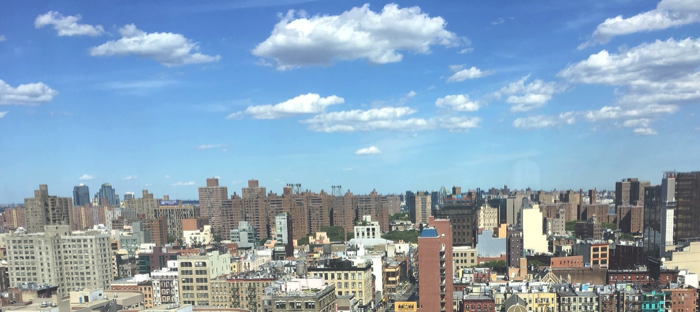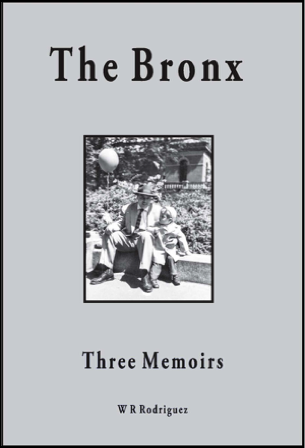
The Bronx: Three Memoirs
Sample from The Bronx: Three Memoirs

The Bronx: Three Memoirs
Zeugpress
2016
ISBN: 978-0-9632201-5-8
Peerfect Bound, 62pp.
https://www.lulu.com/spotlight/wrrodriguez
The Bronx: Three Memoirs
Zeugpress: Smashwords Edition
2016
ISBN: 9781310721571
E-publication
www.smashwords.com/books/view/639558
From 138th Street and Brook Avenue
Sometime during the 1920s my grandfather brought a shoeshine parlor on the southeast corner of 138th Street and Brook Avenue. My grandfather was an Italian immigrant who had moved from Philadelphia to Manhattan, then to a tenement on 134th Street in the South Bronx; when it was razed to make way for the Major Deagen Expressway, he settled on 138th Street so that he could be near his business. Nine of his eleven children survived childhood, and four of his five daughters rented apartments on 138th Street where they raised their own families. The American dream of a house in the country was not a possibility for them; surviving the Depression and paying the bills was enough. It was their children who made the great exodus to the suburbs.
I grew up with a sense of family that I will probably never experience again. There were fourteen cousins of a variety of ages distributed among 514, 522, and 526 East 138th Street. There was always someone for the kids to play with, and there was always something for the adults to talk about. On summer afternoons the mothers gathered, leaning on parked cars or sitting on milk crates, and watched as we played. On hot summer nights the fathers joined them. I was born in 1953, and I lived on 138th Street until 1971. The ’50s and ’60s saw many changes in national and local politics; the Cuban Missile Crisis prompted worried conversations about a cousin in the navy; the Kennedy assassination was a mortal shock; Mayor Lindsay provided anger and amusement. But much of the talk was centered on the family and the neighborhood: Who was arguing? Who was getting married? Who was moving? Where was there to move?
From Fordham
As the 1970s flowed into the 1980s, life in the city seemed to grow more difficult. The Woodlawn train became known as “The Muggers’s Express,” and my father started taking the D train home at night. The South Bronx, now an epithet for urban blight, extended up to Fordham Road. Crime surged, and I remember the stories of stores closing early on Halloween to avoid being robbed by people in masks. Drug sales occurred right on the street, in broad daylight, so much so that Mom stopped looking out the window to avoid any repercussions if there happened to be a bust. On one visit home we saw Curtis Sliwa on Fordham Road. He was toting a black plastic garbage bag as he was part of a group attempting to reduce litter in the area. The Guardian Angels, which he founded, patrolled the Woodlawn train, and I know my parents appreciated this effort to protect the public.
As for myself, I avoided subways and took cabs. Many drivers did not want to go to The Bronx. Some refused outright, some gave in after I explained the route and assured them that they could quickly get out of The Bronx and back to Manhattan: make a left at Fordham and zip over to the Deagan or the Harlem River Drive. After we had children, we occasionally used the strategy of putting them in the cab first and negotiating later. This ploy was best executed at LaGuardia Airport, where there was so much traffic that the likelihood of the driver kidnapping the kids and speeding off was greatly diminished. The most enjoyable rides were with older drivers who had once lived in the area. We could talk about the good old days. In one ride down the Grand Concourse, I was shocked to see the boarded-up buildings. Years later I was pleased to see renovation and a new life for these beautiful edifices.
From: My Mother’s Life in Mott Haven
Mom’s earliest memory is of that day in 1925 when the family moved to The Bronx: the moving man yelled at her and her brother who were jumping on the mattress. The family settled in at 535 East 134th Street. Between Brook and Saint Ann’s Avenues, 134th Street consisted of private houses and tenements, a small cookie factory, and a dairy. The apartment was a cold water flat which had a coal stove in the kitchen. There was one bedroom for the boys, one for the girls, and one for the parents. With so many girls crammed into one bed, Mom often snuck into the living room to sleep on the sofa bed. In the summers this was the coolest room, so sometimes there was competition for this choice spot, but Mom argued that she had priority because she often slept there in the winter when it was the coldest room. Being the youngest, she did not always win.
Sharing the boys’ room was Uncle Giaco. Giaco had emigrated to America, and a relative was supposed to meet him at the dock. When the ship landed no one was there to meet him. Somehow he met my grandfather who took him in. He worked in the shoeshine parlor and lived with our family for the rest of his life. Giaco returned to Italy once to visit his relatives, but, despite his American citizenship, he was told that he would be drafted into the Italian army. He had served as a runner for General Pershing in the United States Army during World War I, so he remained on the boat and did not set foot on Italian soil. He never tried to return to Italy after that. In 1954 he was struck down by an automobile while crossing 138th Street to buy some ice cream. He is buried in the family grave at Saint Raymond’s Cemetery.
My mother’s childhood in The Bronx during the 1920s and 1930s is still vivid in her memory. Doors were left unlocked; sometimes the milkman left the milk inside the door. There were few cars and children could walk to school or to the park without worrying their parents. Mom and one of her brothers sometimes walked miles to visit their aunt; they followed the trolley tracks up Saint Ann’s Avenue and went crosstown on 149th Street. On one of these wanderings Mom and her brother stayed too long fishing and crabbing on the docks of the Harlem River. They arrived home after dark, and my grandfather was so angry that he threatened to get out the belt. Mom dashed into the bedroom and hid under the bed for the rest of the night. Her brother simply handed over the crabs which were promptly cooked and eaten amid laughter and conversation. But Mom played it safe and did not venture out for a snack. . . .
. . . Mom has always been an avid Yankee fan. Mom almost saw Babe Ruth play, but she got home from school too late and her father took one of her sisters to the game instead. When she was ten or eleven, she attended Sunday doubleheaders with her oldest brother. He was a policeman working the vice squad in plainclothes. Mom suspects that he was there to keep track of the bookies. He would sit her down and go off to do his work. He would occasionally return to check on her and to bring her ice cream. When she was in high school she attended ladies days: a quarter admission for any seat in the house; this eventually changed in the 1940s, and the women were relegated to the grandstands. The morning session at Commercial High let out at noon, so on Fridays Mom and her friends headed uptown to the ballpark. If the Yankees were on the road, the Giants were at the Polo Grounds. One of her teachers knew Lou Gehrig and they often sat behind the Yankee dugout. After the games the fans could run onto the field. Once Mom got close enough to Joe DiMaggio to ask for his autograph; he was just about to take her pencil and sign her scorecard, but a policeman intervened and moved the fans away. She has never forgotten that brief moment with one of her heroes.
Mom not only enjoyed watching sports, she also loved participating in them. The girls in her high school class would get together and play softball in the schoolyard of PS 52. She joined the PAL and began playing on a girls’ basketball team. After high school she got a job at S.H. Kress & Company Five & Ten on 106th street. She began rollerskating with her coworkers at the rink on 188th and Park. Even when the other ladies lost interest in the sport, she continued. Gay Blades, on 52nd Street near Broadway, was often crowded with servicemen. The Fordham Skating Rink had curved edges, so it was not one of her favorites. When she came home after an evening of rollerskating, she always stopped in Jake’s candy store at 518 East 138th Street. Jake would let her in even at closing time, which was at 11 or 11:30, and make her a big malt or an ice cream soda piled with whipped cream. He thought she was too skinny and needed the extra calories. Mom was quite active. She was up at five, off to work, home for dinner, and out to skating, in bed at midnight. The subways and streets were safe, the Depression was over, and, for those who were not going to war, life in The Bronx was fun. . . .
The Bronx: Three Memoirs is available as an e-publication from Smashwords:
www.smashwords.com/books/view/639558